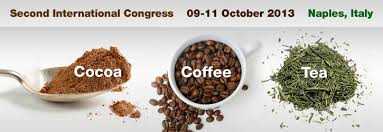Bakuradze T.1, Becker I.1, Thill T.1, Pickard S1., Montoya G.1, Merz K.H.1, Eisenbrand G.1, Richling E.1 1 Technische Universität Kaiserslautern, Erwin-Schroedinger-Straße 52, 67663 Kaiserslautern, Germany. Email: Richling@chemie.uni-kl.de Coffee brew, a complex mixture of more than a thousand bioactive compounds, is known to exhibit distinct antioxidant activity. The antioxidant activities are attributed to compounds, formed during roasting, such as Maillard reaction products (e.g. melanoidins) or others present in coffee prior roasting.
It is, however not clear which constituents are most efficient in protecting cells against oxidative damage or influence the homeostasis of intracellular cyclic nucleotides.
Alkylpyrazines are formed during the roasting process as a result of the Maillard reaction between sugar and amino acids and have greatest impact on the coffee flavor [1].
A stable isotope dilution assay based on GC- MS analysis (SIDA-GC-MS) was developed for the quantitative analysis of twelve alkylpyrazines found in commercially available roasted ground coffee samples.
The most abundant alkylpyrazine in all coffee samples was 2-methylpyrazine (2-MP), followed by 2,6-dimethylpyrazine (2,6-DMP), 2,5- dimethylpyrazine (2,5-DMP), 2-ethylpyrazine (2-EP), 2-ethyl-6-methylpyrazine (2-E-6-MP), 2-ethyl-5- methylpyrazine (2-E-5-MP) and 2,3,5-trimethylpyrazine (2,3,5-TMP), respectively. Among the alkylpyrazines tested 2,3-dimethylpyrazine (2,3-DMP), 2-ethyl-3-methylpyrazine (2-E-3-MP), 2-ethyl- 3,6-dimethylpyrazine (2-E-3,6-DMP), and 2-ethyl-3,5-dimethylpyrazine (2-E-3,5-DMP) showed the lowest concentrations in roasted coffee.
The total concentrations of alkylpyrazines in commercially available ground coffee ranged between 82.1 mg kg-1 and 211.6 mg kg-1.
Additionally, we investigated the influence of brewing techniques and storage on the alkylpyrazine amounts of coffee brews.
We were able to show that the alkylpyrazine profiles did not change from grounded coffee to the brews. In total, in the ground coffee used we determined 162.2 ± 2.8 mg kg-1 alkylpyrazines. Depending on the brewing method between 113.3 ± 3.5 mg kg-1 and 132.6 ± 0,6 mg kg-1 were found (70 to 82%) [2].
Brewing temperatures above 50°C did not significantly influence the alkylpyrazine amounts. The total amount of alkylpyrazines ingested by cup ranges between 1.7 to 2.0 mg alkylpyrazines per 250 ml cup (prepared of 15 g of ground coffee).
To clarify whether the pyrazines exhibit a biological activity such as the antioxidant capacity or cellular energy homeostasis are not known yet.
Parameters studied were glutathione level and protein expression of the rate-limiting enzyme of glutathione synthesis -glutamylcysteine ligase in human colon cancer cell lines (HT29, Caco-2).
Glutathione levels were significantly increased by high substituted alkylpyrazines such as 2-E-3,5(6)-DMP, 2,3,5- TMP and 2,5-DMP at low concentrations (0.1-10 μM) in both cell lines.
Similar to the glutathione level, the -glutamylcysteine ligase protein levels were distinctly induced by high substituted alkylpyrazines.
Taken together, these in vitro results suggest that highly substituted alkylpyrazines might have the potential to increase cellular antioxidant defence
Additionally, effects of individual pyrazines were investigated on PDE activity in lysates of human platelets. PDE activity was inhibited to a varying extent with half maximal inhibitory concentrations (IC50).
Individual pyrazines inhibited PDE activity similar to caffeine (IC50 0.7 mM). In conclusion, pyrazines clearly show a biological activity in vitro and are consumed on a daily basis in the mg range via coffee.
1. Shibamoto, T.; Bernhard, R. A., Investigation of Pyrazine Formation Pathways in Sugar-Ammonia Model Systems. J. Agric. Food. Chem. 1977, 25, 609-614.
2. Pickard, S., Becker, I., Merz, K.H, Eisenbrand, G., Richling, E. Quantitative Analysis of Alkylpyrazines in Coffee Powder using Stable Isotope Dilution Gas Chromatography-Mass Spectrometry (SIDA-GA-MS). J. Agric. Food Chem., submitted
















